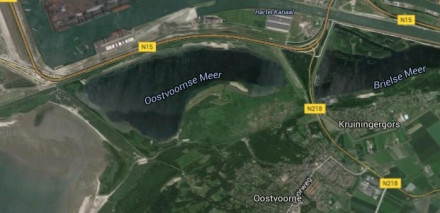History
The Oostvoornse Meer
The Oostvoornse Meer (Oostvoornse Lake) was created in the 1960s by the construction of the Brielse Maasdam in the 1950s and the Brielse Gatdam in the 1960s, both part of the extensive water management projects undertaken around Rotterdam. After the area was closed off, forming the lake, sand excavation in the lake was undertaken to provide sand for the construction of the Maasvlakte 1.
This revealed a high concentration of wrecks underneath the lake bed. The sand at the bottom of the waterway would have quickly swallowed any wrecked vessel, and worked throughout the centuries to highly preserve any remains. Unfortunately, the changes introduced to the waterway presented a danger to the remains in the lake. The sand mining exposed and disturbed many of the wrecks, ranging from partial disturbances to total degradation, and many wrecks that were previously buried are now exposed. This has led to a high rate of sports diving on and illegal excavation of the wrecks. Another threat to the shipwrecks is the timber-eating worm Teredo navalis, also known as the naval shipworm. Although the closure of the lake led to a freshening of the water, efforts since 2007 to re-salinate the lake have led to a recurrence of the worm. The timber wrecks lying in the Oostvoornse Meer are at a high risk of destruction due to this organism.
The area was a very busy waterway for shipping since the late Middle Ages, and the lake presently contains the remains of more than a dozen wrecks spanning from the 16th-20th centuries, although most date from the early 17th century. This is most likely due to the presence of an infamous sandbank during that time, which was referenced on a map from 1645 as de Hondenplaat.

Description
The Oostvoornse Meer 10 (OVM 10) is a 17th-century wooden shipwreck found in the Oostvoornse Meer, the Netherlands. The site possibly contains two shipwrecks, although that is not clear yet.
Status
In 2014 an inspection dive was made to several wrecks in the Oostvoornse Meer, including a dive to the Oostvoornse Meer 10 (OVM 10). The wreck site contains two locations on both sides of a small hill, an eastern location and a western location, with 20 m in between. It is possible the wreck site contains two shipwrecks.
During the inspection a lot of loose ship parts, some still connected, were found on both locations. Among these parts are thin shell plankings and heavy beams. The outer layers of the beams have been affected by shipworm. The insides of the beams have not yet been affected by shipworm activity
A wood sample taken by sport divers had been dated to 1596. In combination with the inspection dives in 2014, the ship has, for now, been dated to the early 17th century.